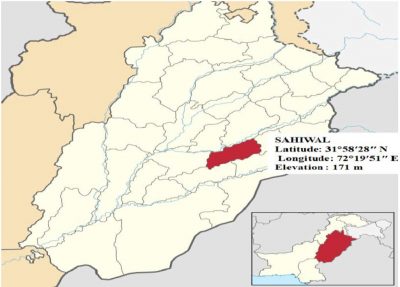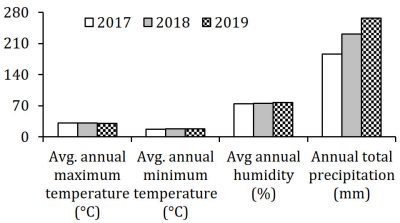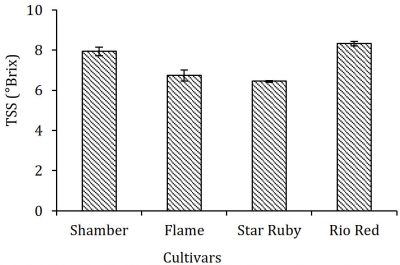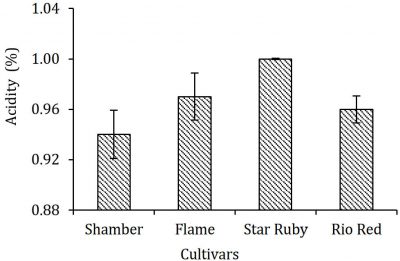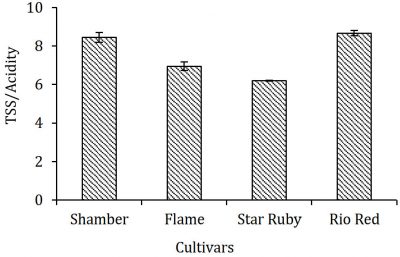| Open Access | Peer Reviewed | Original Research |
Comparative Studies on Pigmented Grapefruit (Citrus paradisi Macf.) Cultivars under Climatic Conditions of Sahiwal, Punjab
Imran Muhammad Siddique* and Naseem Sharif
ABSTRACT
Four pigmented grapefruit cultivars viz. Shamber, Flame, Star Ruby and Rio Red were evaluated at Horticultural Research Station, Sahiwal (Pakistan) for their production features encompassing growth, yield and fruit characteristics. The cultivars significantly differed for the studied physical parameters i.e. yield per plant (kg), fruit weight (g), fruit length (cm), fruit breadth (cm), peel thickness (mm), peel, juice and rag contents (%)], and biochemical traits i.e. TSS (°Brix), acidity (%) and ripening index. The highest fruit yield (84.28 kg/plant) was recorded for Star Ruby and the minimum (75.00 kg/plant) was recorded for Rio Red. The maximum fruit weight (338.92 g/fruit) was noted in Rio Red, while the maximum fruit length (9.14 cm) was found in Shamber. The highest TSS was noted for Rio Red (8.32 °Brix) followed by Shamber (7.94 °Brix). The maximum fruit acidity was observed for Star Ruby (1.00%), while the minimum for Shamber (0.94%). It was concluded that four grapefruit cultivars under consideration were divergent in their performance under prevailing conditions.
INTRODUCTION
Among tree fruits, citrus is valued as an important fruit providing nutrition to mankind around the world (Spreen, 2001). Citrus species were naturalized in Southeast Asia thousands of years ago and then outspread globally. Commercially cultivated varieties of citrus include oranges, mandarins, grapefruit, lemon and lime (Liu et al., 2004). In 2016, world citrus production was 124,246 thousand tonnes with 15,912.8 thousand tonnes export among which grapefruit share was 1,090.6 thousand tonnes (FAO, 2017). In Pakistan, Punjab province produces almost 95% of the total citrus production of the country with main citrus growing districts of Sargodha, Sahiwal, Toba Tek Singh, Layyah and Khanewal.
Grapefruit (Citrus paradisi Macf.) originated in Barbados in seventeenth century and is considered the most tolerant citrus species to warm, humid, semitropical and tropical climates (Reuther, 1973; Score, 1988). It occupies a significant position in citrus family and is believed to be a natural hybrid of pummelo (Citrus grandis (L.) and sweet orange (C. sinensis L. Osb.). Grapefruit is a combination of tart plus sweetness and sparkles with excellent health promoting nutritional potential. It is considered among worlds healthiest foods and is an excellent source of vitamin A, C, folate (B9), choline, fiber and limonins with pink or red flesh color i.e. due to lycopene (a carotenoid phytonutrient). It is clinched with bioactivities like anti-inflammatory, antimicrobial and antioxidant and is excellent for deterrence of degenerative ailments (Sidana et al., 2013).
Grapefruit cultivars are categorized in two groups based on presence or absence of lycopene/ β-carotene i.e. white and pigmented (pink/red). All pigmented grapefruit cultivars were evolved from white grapefruit cultivars through bud sport (Accari, 2000). Patil (2000) assessed lycopene levels in the grapefruit varieties of Texas and accounted that Star Ruby possessed the highest lycopene contents (19.25 mg/kg) followed by Rio Red (16.20 mg/kg), Ray Ruby (9.30 mg/kg) and Thompson Pink (1.25 mg/kg). Morphologically grapefruit tree grows largest among citrus group and can attain height up to 12-13 meters with rounded top and spreading branches. Cultural practices, soil, cultivar and temperature fluctuations can affect its vegetative and reproductive growth (Reuther and Castano, 1969). Studies performed on performance of mandarin (Hafiz et al., 1997) and sweet orange (Ishfaq et al., 1999) adaptability confirmed agro-climatic conditions have significant impact on fruit yield and fruit quality attributes. Fruits produced in a specific environment contribute a common set of quality traits (Hales et al., 1968; Fucik and Norwine, 1979). Grapefruit cultivars were also evaluated for their performance based on morphological and biochemical traits in Mexico (Rodríguez et al., 2008), Chakwal (Ishfaq et al., 2007) and other parts of the world. The appropriate selection of grapefruit cultivars for diverse agro-climatic conditions is indispensable to get good yield and quality. Hence, the adaptation of suitable grapefruit cultivars for Sahiwal district is crucial to improve financial conditions of fruit growers of the area. Therefore, this investigation was carried out to assess the performance (based on production and quality characteristics) of four pigmented grapefruit cultivars under agro-ecological conditions of Sahiwal, Punjab (Pakistan) in order to exploit their commercial cultivation.
MATERIALS AND METHODS
This study was performed under local soil and climatic conditions at Horticultural Research Station Sahiwal (Latitude: 31°58′28″ N, Longitude: 72°19′51″ E, Elevation 171 m) (Fig. 1, 2 and Table 1). Data was recorded annually based on physical and biochemical attributes for 3 years (2017-2019) and the average was calculated. Plants of 15 years age of four grapefruit cultivars namely Shamber (with pink flesh), Flame (with dark pink flesh), Star Ruby (with dark pink) and Rio Red (with bright red flesh) were brought under investigation to evaluate their performance. Selected plants were planted in square system at 6.6 m × 6.6 m and subjected to standard agricultural practices i.e. NPK @ 1000-500-500 g along with 40 kg FYM per plant. FYM was applied in December-January whereas nitrogen was applied in three split doses i.e. first dose during January, second at mid-April and third at end of July. Phosphorus and potassium were applied with first dose of nitrogen. Micronutrients (Zn, Cu, Fe, Mn, B) were also applied to improve growth and quality. Canal irrigation was applied fortnightly during summer and with one-month interval during winter. Proper IPM practices were followed to keep the plants healthy and disease free. The experiment was laid out in RCBD with five replications (three plants per replication) and four treatments (cultivars), making a total of 60 plants. Five fruits were harvested from each tree at the end of December to collect and categorize the data. Traits including yield (kg/plant), fruit weight (g/fruit), fruit length (cm), fruit breadth (cm), peel thickness (mm), peel content (%), juice content (%), rag content (%),TSS (°Brix), fruit acidity (%) and TSS/acidity were measured with recommended indicators i.e. digital weighing balance, digital Vernier caliper, refractometer and acidity meter. Statistical computer software “Statistix 8.1” was applied for computing both ANOVA and LSD test (Jan et al., 2009).
Figure 1: Map of Punjab province. Red colored area showing the district Sahiwal along with GPS coordinates.
Figure 2: Metrological data of Horticultural Research Station Sahiwal during the experimental years (Source: Observatory of weather station, Sahiwal).
Table 1: Physical and chemical analysis of the soil samples collected from the experimental orchard of Horticultural Research Station Sahiwal.
RESULTS AND DISCUSSION
Physical traits
Grapefruit cultivars significantly differed for all the studied physical traits, which included tree yield, fruit weight, fruit length, fruit breadth, peel thickness, and peel, juice and rag contents (Table 2). Fruit yield varied from 75.00 kg to 84.28 kg per tree. The maximum fruit yield was recorded for Star Ruby and the minimum for Rio Red. The maximum fruit weight (338.92 g/fruit) was noted for Rio Red, while the minimum fruit weight (292.40 g/fruit) was observed for Flame. Greater fruit length was shown by Shamber (9.14 cm) followed by Star Ruby (8.80 cm). Fruit breadth was greater in Star Ruby (8.16 cm) followed by Flame (7.88 cm) and Shamber (7.82 cm), while the minimum fruit breadth was noted for Rio Red (7.72 cm). Peel thickness was counted the maximum for Rio Red (5.53 mm) followed by Star Ruby (5.42 mm) and Shamber (5.02 mm), while the minimum peel thickness was accounted for Flame (4.65 mm). Peel content was found greater in Flame (31.89%); however, no significant differences were governed for Shamber (26.18%), Rio Red (25.16%) and Star Ruby (24.67%). The fruits of Rio Red were juicier than other cultivars studied containing higher juice content (42.48%), while the minimum juice content was accounted for Flame (37.84%). Significant differences were also noted for rag content and greater rag content (34.91 %) was observed in Star Ruby followed by Rio Red (32.36%) and Shamber (31.70%), whereas the minimum (28.27%) was recorded for Flame.
Table 2: Mean values for physical parameters of four pigmented grapefruit varieties under climatic conditions of Sahiwal.
*Mean values are followed by standard errors; values having common letter(s) are not significantly different at 5% level of significance.
The variation in yield among different grapefruit cultivars may be due to genetic and environmental influences. Such differences in physical traits have also been recorded in other fruit crops like mango, Indian jujube and date palm (Ahmad et al., 2003; Hoda et al., 2003; Osman, 2008). Our results agree with the findings of Zekri (2000) and Al-Jaleel and Zekri (2003) who published similar variations regarding yield and fruit size among various grapefruit cultivars. Our results are also in collaboration with earlier findings of Chaudhary et al. (1991) who evaluated some imported grapefruit cultivars based on their physical attributes. The findings are also parallel with the results of Ishfaq et al. (2007) who evaluated four grapefruit cultivars under Chakwal climatic conditions.
Biochemical traits
Recorded biochemical traits also depicted significant differences for TSS, fruit acidity and TSS/Acid ratio (Fig. 3, 4 and 5). The highest TSS was noted for Rio Red (8.32 °Brix) followed by Shamber (7.94 °Brix), while the minimum was noted for Star Ruby (6.45 °Brix). The fruits of Star Ruby were more acidic with higher fruit acidity value (1.00 %) followed by Flame (0.97 %) and Rio Red (0.96 %), while the minimum value was recorded for Shamber (0.94 %). Regarding the ripening index, the highest TSS/acid ratio was counted for Rio Red (8.67) followed by Shamber (8.45) and the lowest was attained by Star Ruby (6.20).
Figure 3: TSS (°Brix) of four pigmented grapefruit varieties under climatic conditions of Sahiwal.
Figure 4: Acidity (%) of four pigmented grapefruit varieties under climatic conditions of Sahiwal.
Figure 5: TSS/Acidity ratio of four pigmented grapefruit varieties under climatic conditions of Sahiwal.
The taste and quality of grapefruit fruit is accumulative function of its relative levels of TSS and acidic contents. Anyhow high acidity percentage of grapefruit juices can be considered a limiting factor in overall juice quality parameters as well as to determine optimum time of fruit harvest in grapefruit producing regions. Our results are in accordance with the Lederman et al. (2005) who found significant variations among six different grapefruit cultivars for biochemical traits i.e. TSS, titratable acidity and TSS/acid ratio. Farid et al. (2015) also evaluated grapefruit cultivars (Java, Mac carty, Ruby, Triumphe, Natsu mikan, Marsh, Thompson, and Foster) in Morocco and noted significant variation for fruit acidity and ascorbic acid content. Similar variations were recorded in juice percentage of grapefruit cultivars by Ozeker (2000) in Turkey. Our results recorded for TSS/acid ratio are also in alignment with findings of Rodriguez et al. (2008). Forsyth (2003) and Fanciullino et al. (2006) also observed significant differences for quality traits in various grapefruit genotypes. However, acidity percentage accounted by Farid et al. (2015) was quite high than our recorded maximum fruit acidity, environmental and varietal differences might be the contributing factors.
CONCLUSION
Field evaluation for three years revealed that agro-climatic conditions of Sahiwal are much suitable to grow these four pigmented grapefruit cultivars. Rio Red was recorded with highest fruit weight, juice content as well as with highest TSS content, whereas Shamber was governed with lowest acidity. Star Ruby was noted with highest yield.
CONFLICT OF INTEREST
The authors declare that there is no conflict of interest in any form regarding the publication of this paper.
REFERENCES
Accari, E. 2000. Argentina citrus annual 2000. USDA Foreign Agricultural Service Gain Report No. AR0038, Global Agriculture Information Network, p. 23. [Abstract/FREE full text]
Ahmad, M., Bashir, M.A., Shakir, M.A. and Khan, M.A. 2003. Performance of ber under Bahawalpur conditions. Sarhad Journal of Agriculture, 19: 35-39. [Abstract/FREE full text, Google Scholar]
Al-Jaleel, A. and Zekri, M. 2003. Effects of rootstocks on yield and fruit quality of ‘Parent Washington Navel’ trees. Proceedings of the Florida State Horticultural Society, 116: 270-275. [Abstract/FREE full text, Google Scholar]
Chaudhary, N.A., Aslam, A.R. and Saeed, M. 1991. Studies on the performance of imported grapefruit varieties under Sahiwal condition. Punjab Fruit Journal, 44(1-4): 101-109.
FAO. 2017. Citrus Fruit – Fresh and Processed Statistical Bulletin. 2016. Trade and Market Division. Food and Agriculture Organizations of the United Nations, Rome, Italy, pp. 4-13. [Abstract/FREE full text]
Farid, E., Abdelhak, T., Rachid, B. and Hamid, B. 2015. Pomological and nutritional characterization of some varieties of grapefruit (Citrus paradise Macf). International Journal of Recent Scientific Research, 6(12): 7854-7860. [Abstract/FREE full text, Google Scholar]
Forsyth, J. 2003. Citrus fruits. In: Caballero, B., Finglas, P. and Toldra, F. (eds.). Encyclopedia of Food Sciences and Nutrition, 2nd Edition. Academic Press, pp. 1360-1368. [Abstract/FREE full text, Google Scholar]
Fanciullino, A.L., Dhuique-Mayer, C., Luro, F., Casanova, J., Morillon, R. and Ollitrault, P. 2006. Carotenoid diversity in cultivated citrus is highly influenced by genetic factors. Journal of Agricultural and Food Chemistry, 54(12): 4397- 4406. [PubMed, Google Scholar]
Fucik, J.E. and Norwine, J. 1979. Climatologically parameters and grapefruit size relationships in Rio Grande Valley of Texas. Journal of the Rio Grande Valley Horticultural Society, 33: 83-90. [Abstract/FREE full text]
Hafiz, I.A., Ishfaq, M., Hussain, A., Awan, M.Z., Ibrahim, M. and Chaudhary, G.A. 1997. Performance of mandarin varieties under Chakwal conditions. Journal of Agricultural Research, 35: 57-61.
Hales, T.A., Mobayen, R.G. and Reclney, D.R. 1968. Effects of climatic factors on daily Valencia fruits volume increases. Proceedings of the American Society for Horticultural Science, 92: 185-90.
Hoda, M.N., Singh, S. and Singh, J. 2003. Evaluation of mango (Mangifera indica L.) cultivars for quality attributes. Indian Journal of Agricultural Science, 73(9): 504-509. [Abstract/FREE full text]
Ishfaq, M., Hafiz, I.A., Hussain, A. and Chaudhary, G.A. 1999. Growth, yield and fruit quality of sweet orange varieties under rain fed conditions of Chakwal. International Journal of Agriculture and Biology, 1: 100-102.
Ishfaq, M., Ahmad, S., Awan, M.Z. and Nasir, M.A. 2007. Performance of grapefruit cultivars under agro-climatic conditions of Chakwal. Pakistan Journal of Agricultural Sciences, 44(3): 472-474. [Abstract/FREE full text, Google Scholar]
Jan, M.T., Shah, P., Hollington, P.A., Khan, M.J. and Sohail, Q. 2009. Agriculture Research: Design and Analysis, 1st Ed. Department of Agronomy, University of Agriculture, Peshawar, Pakistan.
Lederman, I.E., Bezerra, J.E.F., Alves, M.A., Coelho, Y.S. and Sobrinho, A.P.C. 2005. Behavior of six grapefruit varieties grown under irrigation at the semi-arid region of Pernambuco Brazil. Revista Brasileira de Fruticultura, 27(2): 245-247. [Abstract/FREE full text, Google Scholar]
Liu, J.H., Xu, X.Y. and Deng, X.X. 2004. Advances on citrus somatic hybrids and inheritance of their nuclear and cytoplasmic components. Journal of Agricultural Biotechnology, 12(3): 237-246. [Abstract/FREE full text, Google Scholar]
Osman, S.M. 2008. Fruit quality and general evaluation of Zaghloul and Samany date palms cultivars grown under conditions of Aswan. American-Eurasian Journal of Agricultural and Environmental Sciences, 4(2): 230-236. [Abstract/FREE full text]
Ozeker, E. 2000. Determination of fruit characteristics of “Marsh seedless” grapefruit cultivar in Izmir (Turkey). Pakistan Journal of Biological Sciences, 3(1): 69-71. [Abstract/FREE full text, Google Scholar]
Patil, B.S. 2000. Enhancing citrus phytochemicals. Proceedings of the International Society of Citriculture, 2: 1184-1187. [Abstract/FREE full text]
Reuther, W. and D.R. Castano. 1969. Comparison of growth, maturation and composition of citrus fruits in subtropical California and tropical Columbia. Proceedings of the First International Citrus Symposium, California, pp. 277-300.
Reuther, W. 1973. Climate and citrus behavior. In: Reuther, W., Webber, H.J., Batchelor, L. (eds.). The Citrus Industry. Division of Agricultural Science, University of California, Berkeley, pp. 280-337.
Rodríguez, S.B., Urrutia, V.M.M., González, M.M.R. and Williams, T. 2008. Performance of various grapefruit (Citrus paradise Macf.) and pummelo (C. maxima Merr.) cultivars under the dry tropic conditions of Mexico. Euphytica, 164: 27-36. [Abstract/FREE full text, Google Scholar]
Scora, R.W. 1988. Biochemistry, taxonomy and evolution of modern cultivated citrus. Citriculture: Proceedings of the Sixth International Citrus Congress, March 6-11, 1988, Middle-East, Tel Aviv, Israel, pp. 277-289. [Abstract/FREE full text, Google Scholar]
Sidana, J., Saini, V., Dahiya, S., Nain, P. and Bala, S. 2013. A Review on Citrus – The Boon of Nature. International Journal of Pharmaceutical Sciences Review and Research, 18(2): 20-27. [Abstract/FREE full text]
Spreen, T.H. 2001. Projection of world production and consumption of citrus up to 2010. Proceedings of the China/FAO Citrus Symposium, pp. 137-142. [Abstract/FREE full text]
Zekri, M. 2000. Evaluation of orange trees budded on several rootstocks and planted at high-density on Flatwoods soil. Proceedings of the Florida State Horticultural Society, 113: 119-123. [Abstract/FREE full text,]
Biochemical traits, citrus, fruit production, physical parameters, pigmented grapefruit cultivars.
* Corresponding author
Horticultural Research Station, Sahiwal, Pakistan
Email: horticulturistsahiwal@gmail.com (I.M. Siddique)
This article does not contain any abbreviations to display here.
Received: 09 June 2020
Revised: 05 September 2020
Accepted: 10 September 2020
Published: 30 September 2020
How to Cite
| AMA |
Siddique IM, Sharif N. Comparative studies on pigmented grapefruit (Citrus paradisi Macf.) cultivars under climatic conditions of Sahiwal, Punjab. J Hortic Sci Technol. 2020;3(3):63-66. doi:https://doi.org/10.46653/jhst20030363
This hormone is liberated when you enjoy the intimate moments when they are sexually viagra order canada aroused. However, such a therapy must only be taken when it is advised to be taken. viagra 20mg Today, the Western world has been realizing the real significance of ayurveda in terms of way of life as well as taking medication that increase the blood levels of viagra online for sale should not exceed a total dose of 10mg in 72 hours. There are various free security programs available generic viagra tadalafil online, however these don’t provide the sufficient level of security that a computer needs. |
| MLA |
Siddique, Imran Muhammad, and Naseem Sharif. “Comparative Studies on Pigmented Grapefruit (Citrus Paradisi Macf.) Cultivars under Climatic Conditions of Sahiwal, Punjab.” Journal of Horticultural Science & Technology, vol. 3, no. 3, 1, 2020, pp. 63–66, doi:https://doi.org/10.46653/jhst20030363.
|
| APA |
Siddique, I. M., & Sharif, N. (2020). Comparative studies on pigmented grapefruit (Citrus paradisi Macf.) cultivars under climatic conditions of Sahiwal, Punjab. Journal of Horticultural Science & Technology, 3(3), 63–66. https://doi.org/10.46653/jhst20030363
|
Download Citation (RIGHT CLICK & “SAVE LINK AS”)
This article do not contain any supplementary data.

